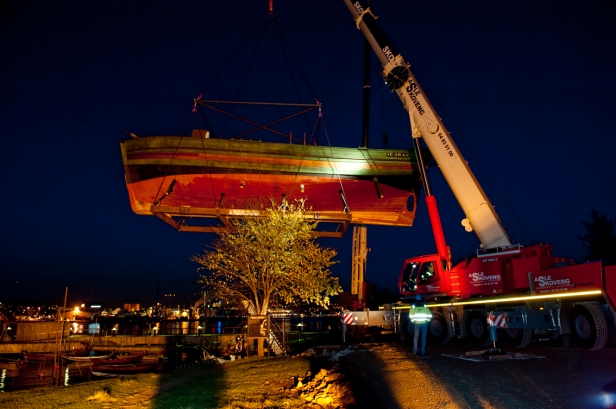I en ukes tid har fem håndverkere fra Hardanger Fartøyvernsenter vært i gang med det som skal bli en større tilbakeføringsoperasjon på Gjøa. Hardangerjagten som Roald Amundsen brukte da han som første mann fann veien gjennom nordvestpassasjen. Det skjedde fra 1903 til 1906 og det var i den tid det fortsatt var mye is i polare farvann, og man nesten hadde gitt opp håpet om å finne en åpning fra Nordatlanteren og over til det nordlige Stillehav. Gjøa kom igjennom og endte opp i San Fransisco hvor hun i 1909 blei landsatt og utstilt i Golden Gate Park. Etter som årene gikk var ikke Gjøa lengre dagens nyhet og stille og rolig forfalt fartøyet. På 1930-tallet begynte man en istandsetting, som stanset helt opp da verdenskrigen kom. I 1947 fortsatte man arbeidet, men uten å satse mer på arbeidet enn at skroget så korrekt ut. Spantene man satte inn fra vannlinjen og opp var heller mangelfulle, og sto med stor avstand. Disse redwood spanteringene står fortsatt i båten og ses som mørke seksjoner blandt spantene Djupevåg båtbyggeri fra Hardanger satte inn da Gjøa blei hentet hjem til Bygdøy på 1970-tallet, 100 år etter at den var bygd. Knut Skaala på Nes utenfor Rosendal bygde Gjøa fra april til oktober i 1873. Det gikk unna den gangen.
For a week now, five ship carpenters from Hardanger Fartøyvernsenter (Hardanger Maritime Center, in English) have worked on what will be a major reversal operation on Gjøa, the Hardanger sloop that Roald Amundsen used when he succeeded in bringing the first vessel through the Northwest Passage.
This voyage took place during the years of 1903-1906. Global warming wasn’t an issue at that time, and the polar waters were covered with ice. Explorers had tried to find the waterway from the North Atlantic to the North Pacific for hundreds of years. Amundsen and his crew sailed Gjøa all the way, and ended up in San Francisco in 1906. She remained in the harbor for the next three years, until Amundsen sold her, and she was brought ashore.
From 1909 to 1972 she was on display in Golden Gate Park. As the years passed, Gjøa became “old news”, and the vessel was not maintained as well as it needed to be. In the 1930s, a restoration program began, only to stop as World War II broke out.
In 1947 the restoration began again. However, historical authenticity was not the focus. For example, most of the metal-work and interior details were removed and only the shape of the hull remained somewhat true to the original form. The heavy, old, pine frames where replaced with narrow, redwood frames, and these stood three times farther apart than on the original vessel.
When Gjøa returned to Norway, in 1972, she came to Bygdøy, in Oslo. Not long after, the boatbuilding company, Djupevåg Boatyard, from Hardanger, restored almost everything above the waterline. The redwood frames are still in the boat and are seen as dark sections among the whiter, pine frames that were placed between them during this restoration.
Gjøa was built in the period of April to October of 1873, by the shipbuilder Knut Skaala Nes from Rosendal, in the Hardanger fiord, and 100 years later she returned to Norway. They knew how to build wooden ships in those days.

Etter at Frammuseet overtok Gjøa fra Norsk Maritimt Museum har Gjøa fått eget hus på lik linje med “Fram”. Fartøyvernsenteret har i et par omganger hjulpet museet med å flytte båten og rigge henne opp igjen inne i det som sannsynligvis blir siste hvilested. Vi tilbakefører for tida skroget tilbake uten å fjerne noe av det som allerede er gjort. Vi tilfører ny materiale slik at skroget skal tåle å stå i museet uten å synke sammen pga. gravitasjonen og for å få fartøyet til å framstå slik det var da Amundsen & Co seilte gjennom nordvestpassasjen. I denne bloggen vil vi framover fortelle litt om dette arbeidet.
Just a few years back, the Fram Museum got Gjøa from The Norwegian Maritime Museum. Soon thereafter, they built a brand new house to honor her, and Roald Amundsen’s explorations in the artic.
Twice already Hardanger Maritime Center has worked on Gjøa. First, we strengthened her so she could be moved into the house, where she now stands, without the risk of breaking apart. Our second task was to rig her up to the standard she is today. During the current work being done, we are going to fit out the boat so that she looks more like she did when she sailed through the Northwest Passage. We are not removing anything, only adding new material, so that she will be strong enough to withstand gravity without sagging. When we are done in June of this year, Gjøa will have her ice sheeting, an extra layer of planks, back on the hull. Inside we are also adding a lot of timber that Amundsen had put in before the voyage. In this blog, we will report from the workplace.


